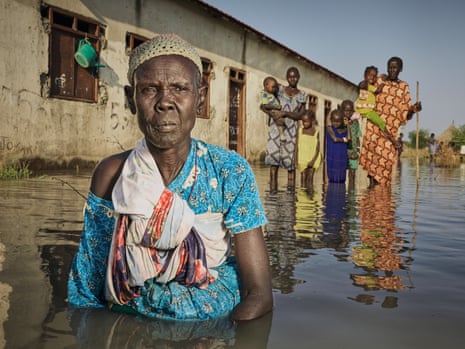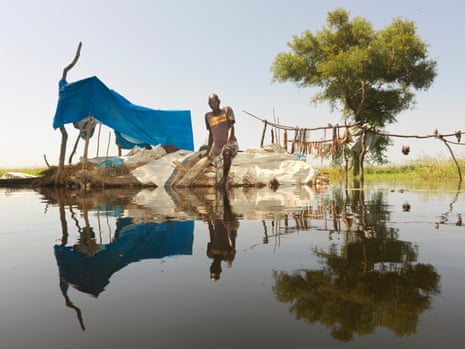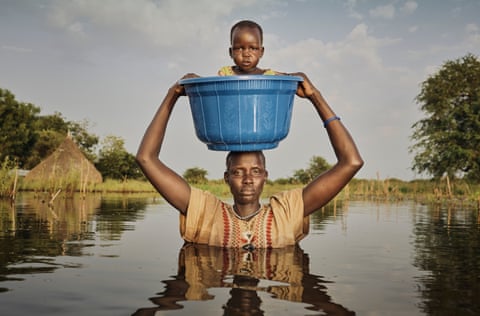After the unprecedented floods last summer, the people of Old Fangak, a small town in northern South Sudan, should be planting now. But the flood water has not receded, the people are still marooned and now they are facing severe hunger.
Unusually heavy rains began last July, and the White Nile burst its banks, destroyed all the crops and encroached on farms and villages, affecting Jonglei and other states, leaving people to scramble for a few strips of dry land.


Fields are still submerged, mud homes and stiff sticks of dead maize are slowly collapsing into the water, entire villages have been abandoned and large areas turned into swamps. Of the 62 villages served by Old Fangak’s central market, 45 are devastated by the flooded river.
The July harvest would have fed the local people through to this spring but all the crops were lost. Families sleep in abandoned schools or in the open on scraps of higher land. There is no question of migrating to dry areas as the flood extends for miles and at least Old Fangak is secluded from the constant conflict that besets much of the rest of the country.

‘Nothing. I couldn’t rescue any of my crops. All were destroyed.’ Nyayua Thang, 62, at Wangchot primary school. She hasn’t eaten in days
The UN says that about 1.6 million people have been affected by the floods in a country where already at least 7.5 million people need assistance. A recent report by the Integrated food security Phase Classification, (IPC), an initiative by 15 organisations to tackle malnutrition, estimates that 6.4 million people, about half the population, will face acute food insecurity in 2021, and for half of them their lack of food will be an emergency.
Some people in South Sudan, such as those from Old Fangak, are partially or completely cut off from humanitarian aid. Access to the town is difficult in normal times, but the detritus of the floods has blocked the airstrip, which was cleared from the bush, and boat access from the river.




Data from South Sudan suggests that more erratic and unpredictable weather patterns are now the norm.
The floods were caused by the Indian Ocean Dipole (IOD), also known as the “Indian El Niño, a weather pattern discovered only in 1999. The strongest IOD to strike east Africa in 61 years happened in 2019. So when the rains arrived in 2020 in South Sudan, the water from the previous year had not yet receded, resulting in more devastating floods. This year’s rainfall could further worsen the situation, making the resultant hunger catastrophic.

‘We always feel weak during the day because of the mosquito bites during the night.’ Nyapata Thiel in the classroom that has become a shelter for many in the community
“People will die of hunger. Everyone in Old Fangak is lacking food and lost what they cultivated. Hunger is the one that will kill people,” says Peter Kak, a fisherman and grandfather of five who lives on a grass island with his son Samuel. The two men stayed behind after sending the rest of the family to higher ground. Here, they fish every day.




“Flooding, conflict, Covid-19 and poverty make the situation here dire,” says Sulaiman Sesay, of Action Against Hunger, one of the few aid organisations active in this area of South Sudan. “The world needs to know that people are suffering in this way.”
The socioeconomic measures adopted in response to the pandemic have affected already critical hunger situations in vulnerable places such as South Sudan. A joint report by the World Food Programme and the UN’s Food and Agriculture Organization estimates that threatening global hunger levels seem to be reaching new highs.

A family works together as night falls to remove flood water from their land
In Old Fangak people grew sorghum, a cereal that is easy to cultivate. Now they can eat only water lilies and fish. But not everyone has fishing nets and for those who do the catches are rarely enough to satisfy the appetite.
“There’s not enough sorghum, so we have to resort to the water lily,” explains Samuel Gai. The flowers have to be collected in great numbers to grind and make a small amount of cereal.
Despite the severity of the floods, the people of Old Fangak refuse to give up. In the face of rising waters, hunger and isolation from the rest of the country, the community shows extraordinary resilience.




“We cooperate,” says Joseph Martin, a villager helping to repair the constantly collapsing airstrip dyke. “The women take the water out with buckets and we put the mud on the dykes to prevent water leaking in. They do their part and we do our part.
“When there is work, men and women work together and they cooperate. Some of the people come and work even without us asking them … this is how we do it, if there is work to save the town, we work together,.”
Moving water by the bucketload all day takes a huge toll on hungry people. “Because of this water, I’ve lost weight. We are doing this alone, all day and night throwing water over the dyke. Nobody comes to help us. We are all exhausted,” says Nyayen Chuol, who works on the dyke with her elderly mother.

Samuel Yong in the makeshift shelter he made on a grass mound to escape the rising water
Where dykes have already been breached many people move on to neighbours’ homes and start again, helping to keep other dykes strong.
“I’m worried all the time. At night I’m trying to stay awake with a fire so I can burn a bit of grass and go check if the dyke is leaking or about to break. Every night. I’m so worried I can’t even sleep thinking that if I fall asleep the dyke could break and I can drown,” says Nyayang Kich, who had to abandon her flooded home for the higher ground of her neighbour.




The water sitting stagnant is compromising health too, leading to a spike in malaria-carrying mosquitoes.
“The climate has changed from the years when I was young because we have never experienced floods like this before. What we are experiencing now is horrible. We are suffering from hunger and we didn’t before. For old people it’s horrible. It’s hard moving in this water; we don’t know where to sleep or what to eat. We are in God’s hands,” says 83-year-old Mary Nyamat.

‘We are surrounded by water and have nowhere to run.’ Nyakeak Rambong, 70
